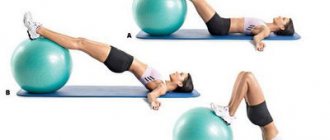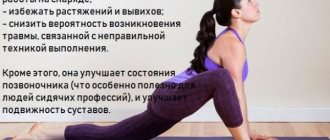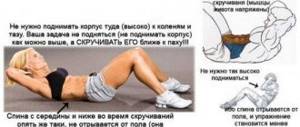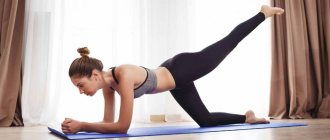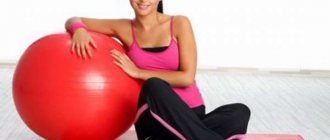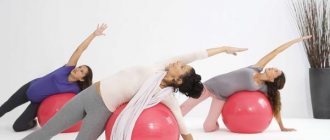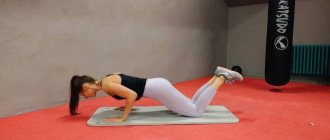What is fitball?
A fitball or gymnastic ball is a unique exercise machine. The rounded shape and wide coverage allow you to perform gymnastic approaches with greater amplitude, and thanks to the instability of this fitness ball, the muscles are kept in tension throughout the entire workout.
From my own practice, I can say that a set of exercises involving a fit ball has a beneficial effect on the spine, helps strengthen the hips, and especially the back and abs. In addition to balanced tone, regular training on the ball helps get rid of pinched intervertebral discs. Such exercises can eliminate pain in the neck/collar area, improve blood circulation, speed up metabolism and fat burning processes.
The condition of the vestibular apparatus, posture is noticeably improved and the muscle corset is strengthened. Your body gains flexibility and lightness, and you gain a cheerful mood.
Are there any contraindications
There are certain diseases for which the use of fitball as one of the treatment methods is not recommended. Among all the contraindications, the following are worth highlighting:
- development of sclerosis (progressive stage);
- pregnancy with complications;
- mechanical damage to the spine resulting from trauma;
- diseases of the cardiovascular system;
- development of pathologies of a dermatological nature;
- intervertebral hernia.
Main contraindications
Despite the fact that at first glance, exercises with a gymnastics doctor seem absolutely safe and harmless, before you start exercising, it would not be a bad idea to consult a doctor for advice. It won’t take much time, but you will be confident in the effectiveness of this treatment method.
Types of fitball
Personally, I have dealt with a variety of different types of these sports equipment. They differ in diameter and elasticity. Each such fit ball can withstand up to 300 kilograms of load weight (at least in practice, I have never seen people exercising with a higher weight). Their diameter can be 45-85 centimeters. First of all, I recommend choosing the size depending on the height of the trainee. Here it would be appropriate to talk about the ratio of your height to the diameter of the ball.
Let me give a typical example of such relationships:
- up to 152 cm – 45 cm
- 152-165 – 55 cm
- 165-185 – 65 cm
- 185-200 – 75 cm
- 200 or more – 85 cm
How to choose the right fitball?
As I already said, the main selection criterion is the height/diameter ratio. To correctly determine this ratio, if you have never seen such a fitness ball, I advise you to sit on the ball and make sure that your hips are at the same level as your knees or slightly higher.
If you decide to purchase a personal projectile, I do not advise you to buy it at markets and other “sharashkin’s offices”. I recommend choosing high-quality balls from those sold in sports stores. Basically, they supply models manufactured in accordance with GOST and relevant standards.
Remember that the correct choice of a fit ball greatly affects the quality of your exercises and the final result. Color and texture are important, of course, but comfort should always be at the forefront.
Try the fit ball to the touch - it should not be sticky and cold, it should not form wrinkles after pinching, and when pressed it should not cushion too much (but not so much that your hand sinks into it).
The main thing to understand is that in order not to harm yourself and to exercise comfortably and with pleasure, you should approach your choice responsibly.
What types of balls are there?
All exercise machines can be divided into two large groups: small balls and large fitballs.
The former are very similar in size to tennis balls, and they can be:
- Singles;
- Double;
- Double with handles.
Single models are universal, less expensive, and come with a smooth surface or with pimples. Double exercise machines are a set of two connected balls that are used to massage the back, or more precisely, the spine and its muscles. Options with handles are a little easier to use.
Important! Almost everyone could see fitballs in a physical therapy room, in fitness or physical education. These are large rubber balls that differ in size and modification: they have horns or not.
The benefits and harms of fitball for the back
If you have a whole range of fitness exercises on your agenda, I strongly advise you to include a fit ball in it. It will help not only diversify gymnastics, but also saturate the program with effective means of strengthening or stretching muscles and ligaments.
I can say that such training is especially effective if you want to strengthen your hips and abs. During the classes, deep muscle groups are worked out, which we rarely include in work by more than 40-50% during normal aerobic exercise. Regular exercise will improve your posture and eliminate pain in the lumbar region.
In general, if you carry out the approaches correctly, do not overload the body, work at the right pace accompanied by an instructor (which is highly desirable), and follow cycles of tension and relaxation, excluding overload and overtraining, such sports activity will not cause harm.
Indications and contraindications for fitball exercises
For hernia
Among the indications for fitball classes for children and adults, I can note intervertebral hernias in various sections, including the collar area, thoracic and lumbar sections. A properly selected program helps relieve pinching, spasm of muscle fibers along the spine and bring them into a healthy tone. I strongly do not recommend such activity at the stage of exacerbation of inflammatory processes.
For scoliosis and curvatures
A special fitball complex is very effective, especially if you have a history of acquired and congenital scoliosis, or a certain stage of spinal curvature. With a competent approach, the vertebrae come to the desired position and are fixed in it at the muscular-ligamentous level. In fact, this is one way to avoid wearing corsets and a good addition to manual therapy.
Speaking about general contraindications, I note that such loads can be dangerous for women in the first trimester of pregnancy and with its problematic course. This activity is also contraindicated in case of isthmic-cervical insufficiency and increased uterine tone. Therefore, before you include it in your complex without the supervision of a fitness trainer, you must consult a doctor.
Back muscle corset
A group of muscles that are located deep and that maintain the correct position of the spine is the muscular corset of the back. In addition, it protects internal organs. What threatens the body with its weakening?
- Slouch
- Weak abdominal muscles
- High likelihood of sprains and injuries
- Risk of diseases: osteochondrosis, radiculitis, intervertebral hernia
- Improper functioning of internal organs
No wonder it got the name corset! Therefore, do not underestimate its importance.
Tips and cautions before starting classes
Before performing a set of fitball exercises for your back, be sure to read the recommendations that I will give below:
- If you are dealing with a fit ball for the first time, you should not try to master the entire complex at once. It is advisable to familiarize yourself with the apparatus, sit comfortably on it and jump. This way you will understand how to maintain balance correctly.
- For maximum comfort and benefit, it is important to choose a ball that suits your height.
- Do not hold your breath under any circumstances - it should be measured and free.
- If you have problems with the spine, you should first consult with a physical therapy instructor - he will tell you which fitball exercises will be useful, how to do them correctly, and select the appropriate pace.
- Conduct classes no earlier than 2 hours after eating.
Warm-up and cool-down
Warm-up and cool-down
- Be sure to warm up and exercise before each fitball workout. You can practice intense running in place or on a treadmill. This way you can warm up your muscles well and prepare them for a full workout, as well as eliminate sprains and cramps.
- Cooling down or relaxing is a mandatory part that should end a fitball workout:
- We place our straightened legs with our calves on the ball.
- We lie down for 10 minutes, breathe freely and relax.
By performing these techniques correctly, you relieve painful spasms of the lower back and unload the muscular spinal corset.
Safety
From my own practice I have learned several important warnings. Firstly, never train earlier than 2 hours after eating and without first warming up! Watch your breathing and don't lose your rhythm. Learn to relax well after each approach. These are three pillars of safe and effective aerobic exercise. Now let’s look at a version of classic fitball training.
Rules for performing exercises
All exercise therapy exercises on a fitball for the back must be performed with precautions and technology in order to obtain the desired effect from the exercises and avoid microtraumas and sprains. It is especially important to be careful when exercising with the apparatus for people suffering from a herniated spine, in severe stages of sclerosis, the elderly and children.
Things to remember when performing exercises on the ball:
- all movements should be smooth, measured, without sudden transitions from one pose to another;
- in each pose you need to linger for 1-2 seconds to achieve the effect of stretching and working out the muscles;
- breathing should be uniform and correct: inhale as you rise, exhale at the moment of relaxation;
- compliance with warm-up, stretching and cool-down is necessary to obtain the desired result;
- you can master exercises of increased complexity only after the skill of working with the simulator reaches automaticity;
- If pain or discomfort in the back appears during exercise, you should immediately stop doing the exercises.
Important! In order to improve the technique, and to be completely sure that each exercise is performed correctly, it is worth checking yourself with a large mirror, and as a sample, watch a video that clearly shows the entire execution process.
A set of exercises for the back and spine
Bridge
This fitball exercise resembles a classic bridge, but unlike it, it is more useful and less traumatic:
- From a supine position, place your calves on the ball, with your hands pressed to the floor.
- Lifting your pelvis off the floor, roll the ball, placing the ball in the middle part of your back, forming a bridge.
- We stay in this pose for 5-10 seconds.
At first, 3 repetitions are enough. You can gradually add one at a time.
Plank
Almost all parts of the body are involved here, including the latissimus dorsi muscles:
- Lying on the ball with your stomach, we begin to gradually roll forward, accompanying the process by finely moving our hands. The feet are placed on the apparatus, and the hands are on the floor, bent at the elbows.
- Leaning on your elbows and palms, we fix your feet in a stable position on the fitness ball.
- We tense the body, draw in the stomach without bending the lower back. Let's look down.
boat
During the execution, a muscle corset is formed, waist size is reduced, and the latissimus muscles are worked out:
- We lie on our stomach on a fitness ball, bring our legs together and stretch our arms forward.
- We slowly bend as we exhale, trying to raise our straightened arms and legs upward.
- Let's hold this position for a few seconds, then lower our legs and arms and relax.
I recommend doing 3 sets with a minute rest between each.
Superman
In this case, we work on the spinal area, abdominal groups, buttock shoulders and back of the thigh:
- Having placed your stomach on the apparatus, we stretch our legs back. We straighten our arms in front of us. Place your palms on the floor, taking the starting position.
- Straighten up and raise your arms to the same level as your body. We pause and return to the starting position.
Hyperextension
These fitball exercises allow you to alternate between relaxation and tension in the lower back, relieving spasm. Additional stabilizing muscle groups are included in the work:
- We lie on the fitness ball with our stomach so that the body fits loosely around the apparatus. We move our hands behind our heads or place them in front of us.
- Raise your body until your legs are in a straight line with your back. Strong deflections should be avoided.
- We hold this position for several seconds and slowly return to the starting position.
I recommend doing 3 sets of 10 repetitions.
Crunches
In this case, we work the abs and stretch the back muscles, effectively burning fat deposits on the sides and lower back:
- Lying on a fit ball, bend your knees at a right angle, rest them on the floor, and place your hands behind your head.
- We lift and lower the upper body, as in a regular ab pump on the floor.
Do 3-15 approaches with a gradual increase in their number from minimum to maximum.
Leg Raise
The main focus is on working the buttocks and hamstrings:
- We lie on the mat and hold the ball with our shins and ankles. We rest ourselves with our hands or put them behind our heads. Strain your lower back and pull in your stomach.
- We squeeze the ball with our feet and lift it to a vertical position. Smoothly lower as you exhale until it makes contact with the floor.
Reviews about using a fitball for the back
Elena, St. Petersburg, 25 years old:
I started working out with a fit ball on the recommendation of a physical therapy doctor. I have a protrusion of the cervical spine. I added training to Dikul’s exercises. A month later I felt good relief in the cervical spine and lightness. My head became clearer, and it became easier to sit through everyday office life. A very effective thing, I recommend it!
Maxim, N. Novgorod, 32 years old:
I went to an orthopedist for a herniated disc in the lumbar region, went for massages, and even visited the Bubnovsky center. It seems like he is on the mend, but somehow very slowly. On the advice of a therapist, I went for a consultation with a fitball instructor. I became interested in the program, made a schedule and started studying. At first it was hard, but after two weeks I felt how my lower back was unloaded, walking, sitting and especially lying down became much easier. I will continue in the same spirit)
